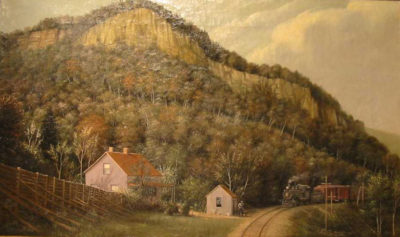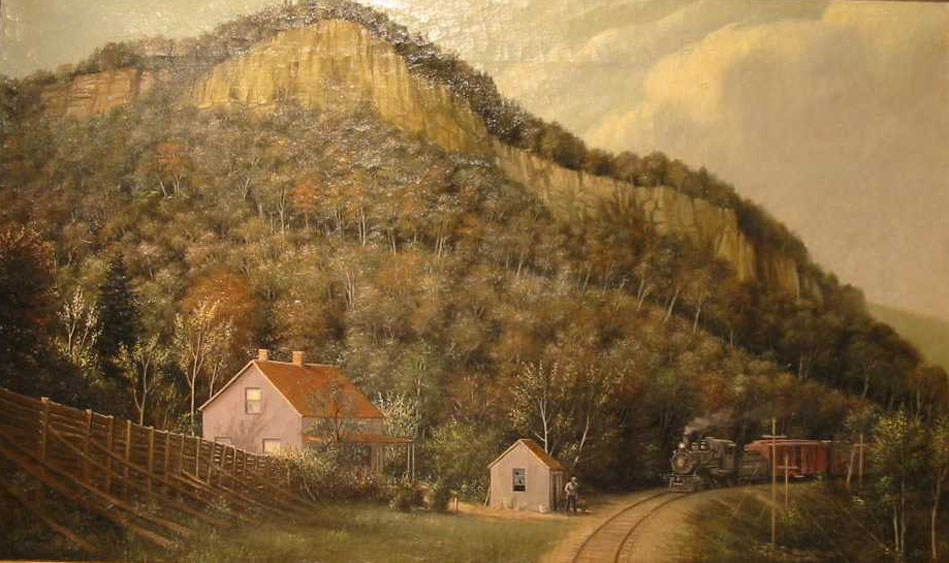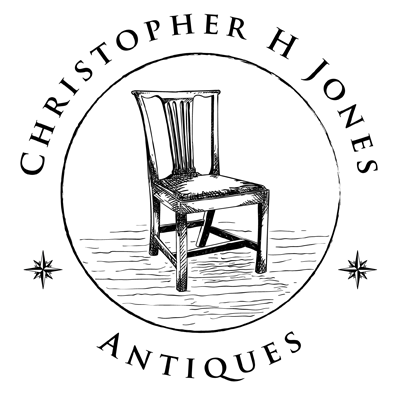
Oil on Canvas, 12″x 20″
Signed “HF” lower left for Harry Fenn (c.1837 – 1911)
N.D. circa 1890
This dramatic view of a steaming locomotive rounding a bend in the Cumberland Gap is one of the few surviving oil paintings by Harry Fenn, among the most well known American landscape illustrators of the nineteenth century. Above the Richmond and Danville track and oncoming freight train can be seen the sloping ridge line which carried the storied Old Wilderness Road through the Cumberland Gap and the rising rock face of the famous Pinnacle. Around 1872, Fenn traveled to the Cumberland Gap and made numerous sketches of the area’s scenery, many of which appeared as illustrations, and likely visited the region at other times during his career. It is possible that he completed this undated painting during one of these visits or, working from his sketches, at a later time. Fenn also toured and sketched similar scenes on the Tennessee River near Chattanooga for Appleton’s Journal in 1871 and along the Hudson River Valley for Harpers Magazine in 1882. Many of the views example the characteristics of composition, perspective and style exhibited in this painting of the Cumberland Gap and evidence his early training as an engraver when he learned to work within the limitations of line and shading inherent in the medium. Notable among these examples of stylistic similarities with respect to this painting were his Richmond from the James, and Mauch Chunk and Mount Pisgah which utilized the same dynamic device of bringing the tracks (or bridge) from right to left and into the forefront and the viewer’s space. As with many of Fenn’s works, these examples feature railroading scenes.
Born in England and trained as a wood engraver, Harry Fenn arrived in the United States around 1857 on “a sketching tour” that quickly evolved into a highly successful lifelong artistic career. Fenn was widely recognized in his day as a landscape painter, illustrator and engraver and was best known for the m
any views he prepared for Picturesque America, published in New York, 1872-1874. Included in these volumes were views of Richmond, Natural Bridge and the Cumberland Gap. Along with providing numerous illustrations for a variety of books and magazines, (including Whittier’s Snowbound), Fenn also toured Europe and the Middle East making sketches for Picturesque Europe, and Picturesque Palestine, Syria and Egypt, which fully established his fame as an artist. Fenn lived with his wife in Montclair, NJ, but maintained his studio in New York where he was a member of the Watercolor Club, the Society of Illustrators, the Salmagundi Club and a founder of the American Watercolor Society. Fenn was awarded a gold medal at the Columbian Exposition of 1893. Writing in the catalog of the retrospective exhibition shortly following Harry Fenn’s death in 1911, a contemporary admirer noted that “though perhaps better known as an illustrator, he was equally capable as a painter in oil and in water colors.”
Condition: The painting survives in excellent condition, is unlined and appears to remain mounted on its original wooden stretcher. The frame is a modern reproduction of an appropriate period design.
Price: SOLD


